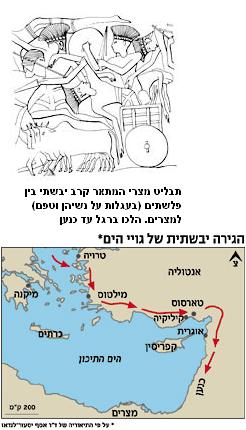According to a new study, the Philistines, who originated in Greece, did not reach the coastal plain in Canaan by ship but migrated on foot through Anatolia and Syria
Ran Shapira

A relief from the funerary temple of Ramses III, ruler of Egypt at the beginning of the 12th century BC, depicts a naval battle between Egyptian soldiers and invaders from the Aegean Sea. According to the bas-relief, the uninvited guests were destroyed in that battle. But the explanation accepted among scholars today sees that battle as the beginning of the migration process of a group of peoples from the Aegean Sea to the shores of Canaan. About two hundred years later, the descendants of those invaders who established themselves were one of the bitter enemies of the Israelites who settled in the mountain - the Philistines.
The migration began following the collapse of the Mycenaean culture, which was characterized by developed art, monumental buildings and a developed writing system. The fall of the cultural system, according to the accepted hypothesis, was accompanied by the establishment of colonies of Aegean peoples in the eastern Mediterranean. The new inhabitants, with their women, their wealth and their property, arrived in the province of Hafzam by sea.
Dr. Assaf Yasser-Landau from the Department of Archeology at Tel Aviv University disputes this hypothesis. According to him, maritime migration of an entire population - men, women, children and men - was not possible in the ships available to the Philistines. The ships that appear in the naval battle relief from the temple of Ramesses III, for example, were intended for war. They carried a team of rowers on board, their personal equipment, and there was no room left for women and children either.
Another argument against the possibility that the Philistines reached the eastern shore of the Mediterranean by sea concerns the number of immigrants. According to the underestimated estimates, several thousand people arrived in the first wave of immigration. According to a broad estimate, they numbered about 25 thousand souls. In the Aegean settlements of that time, which were relatively small, there were not enough oarsmen to bring so many people, says Yassur-Landau. They may have sent a vanguard force in ships, followed by non-combatant men, women and children.
Indeed, next to the naval battle depicted in the relief in the burial temple of Ramesses III, there is also a description of a land battle. In this description women, children and carts pulled by oxen are seen alongside the warriors. The appearance of the women strengthens the claim that the Philistine immigrants arrived by land. A close look reveals that some women do not have an Aegean style hairstyle and among them there are some whose heads are adorned with an Anatolian or Syrian hairstyle. From this, Yassur-Landau concludes, that the immigrants passed through Anatolia and Syria on their way to Canaan. During their stay in each of the countries, connections were made between the men and local women, who joined their journey.
The land migration was made possible, according to him, because the political and military forces that ruled along the road from Greece to Canaan - the Hittite Empire that sat in Anatolia, Ugarit in Syria, and more - collapsed. Thus an entire population could move almost unhindered from Greece or western Anatolia to Canaan. The only powers that maintained their status were the small Mycenaean kingdoms that ruled Miletus and the islands of Rhodes and Kos.
According to Yasser-Landau, the immigrants used these islands as a base of departure. They stayed in them for a certain period and from there they sent a vanguard force to Canaan, after which the rest came. Evidence of the connections between the Philistines and the three islands can be found in their material culture, which was identical to the one they found there. The drinking bowls, cooking pots and other pottery of the Philistines are more similar to those of the islands than to the material culture of mainland Greece. Their religion was also originally a Greek religion. In almost every Philistine house you can find a figurine of Ela, known as "Ashdoda" - a seated, long-necked woman - identical to the ancient Mycenaean earth goddess.
Yassur-Landau, who will present the new discoveries about the Philistines in a series of lectures at the Eretz Israel Museum from the beginning of March, claims that the Aegean immigrants arrived on the shores of Canaan on foot from the north, from Syria, and over the years descended south along the coastal plain, left its inhabitants and founded their cities in Ashdod, Ashkelon, Gaza, In principle and in other places. When a stake was driven into the land, they were the bitter enemy of the kingdom of Israel in the days of Saul, David and Solomon.
History connoisseur - ancient times
About invasions in Wikipedia encyclopedia
https://www.hayadan.org.il/BuildaGate4/general2/data_card.php?Cat=~~~88198116~~~158&SiteName=hayadan
